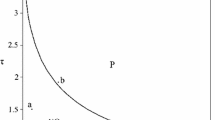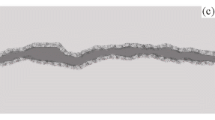Abstract
This work presents at attempt to model brittle ruptures and slips in a continental plate and its spontaneous organization by repeated earthquakes in terms of coarse-grained properties of the mechanical plate. A statistical physics model, which simulates anti-plane shear deformation of a thin plate with inhomogeneous elastic properties, is thus analyzed theoretically and numerically in order to study the spatio-temporal evolution of rupture patterns in response to a constant applied strain rate at its borders, mimicking the effect of neighboring plates. Rupture occurs when the local stress reaches a threshold value. Broken elements are instantaneously healed and retain the original material properties, enabling the occurrence of recurrent earthquakes. Extending previous works (Cowie et al., 1993;Miltenberger et al., 1993), we present a study of the most startling feature of this model which is that ruptures become strongly correlated in space and time leading to the spontaneous development of multifractal structures and gradually accumulate large displacements. The formation of the structures and the temporal variation of rupture activity is due to a complex interplay between the random structure, long-range elastic interactions and the threshold nature of rupture physics. The spontaneous formation of fractal fault structures by repeated earthquakes is mirrored at short times by the spatio-temporal chaotic dynamics of earthquakes, well-described by a Gutenberg-Richter power law. We also show that the fault structures can be understood as pure geometrical objects, namely minimal manifolds, which in two dimensions correspond to the random directed polymer (RDP) problem. This mapping allows us to use the results of many studies on the RDP in the field of statistical physics, where it is an exact result that the minimal random manifolds in 2D systems are self-affine with a roughness exponent 2/3. We also present results pertaining to the influence of the degree β of stress release per earthquake on the competition between faults. Our results provide a rigorous framework from which to initiate rationalization of many, reported fractal fault studies.
Similar content being viewed by others
References
Bak, P., Tang, C., andWisenfeld, K. (1988), Phys. Rev. A38, 364.
Bak, P., andTang, C. (1989),Earthquakes as Self-organized Critical Phenomenon, J. Geophys. Res.94, 15635–15637.
Bray, A. J., andMoore, M. A. (1987), Phys. Rev. Lett.58, 57.
Burridge, R., andKnopoff, L. (1967),Model and Theoretical Seismicity, Bull. Seismol. Soc. Am.57, 341–371.
Carlson, J. M., andLanger, J. S. (1989),Mechanical Model of an Earthquake Fault, Phys. Rev. A40, 6470–6484.
Chen, K., Bak, P., andObukhov, S. P. (1992),Self-organized Criticality in a Crack Propagation Model of Earthquakes, Phys. Rev. A43, 625–630.
Cowie, P., Sornette, D., andVanneste, C. (1993),Statistical Physics Model of Complex Fault Pattern Organization and Earthquake Dynamics, J. Geophys. Res.98, 21809–21821.
Crisanti, A., Jensen, M. H., Vulpiani, A., andPaladin, G. (1992), Phys. Rev A,46, R7363.
Davy, P., Sornette, A. andSornette, D. (1990), Nature348, 56.
Derrida, B., andVannimenus, J. (1983), Phys. Rev. B27, 4401.
Fraysse, N., Sornette, A., andSornette, D. (1993), J. Phys. I France3, 1377.
Grinstein, G., Lee, D.-H., andSachdev, S. (1990), Phys. Rev. Lett.64, 1927.
Grinstein, G., andLee, D.-L. (1991), Phys. Rev. Lett.66, 177.
Huse, D. A., Henley, C. L., andFisher, D. S., (1985), Phys. Rev. Lett.55, 2924.
Hwa, T., andKardar, M. (1989), Phys. Rev. Lett.62, 1813–1816.
Kardar, M., andZhang, Y.-C. (1987), Phys. Rev. Lett.58, 2087.
Mézard, M., Parisi, G., andVirasoso, M. A.,Spin Glass Theory and Beyond (World Scientific, Singapore 1987);
Miltenberger, P., Sornette, D., andVanneste, C. (1993),Fault Self-organization as Optimal Random Paths Selected by Spatio-temporal Dynamics of Earthquakes, Phys. Rev. Lett.71, 3604–3607.
Pietronero, K., Tartaglia, P., andZhang, Y.-C. (1991), Physics173, 22.
Roux, S., andHansen, A. (1992), J. Phys. II France2, 1007–1021.
Scholz, C. H., andMandelbrot, B. B.,Fractals in Geophysics (Birkhäuser, Basel 1989).
Scholz, C. H., andSaucier, F. J. (1993),What Do the Cajon Pass Stress Measurements Say about Stress on the San Andreas Fault?, J. Geophys. Res.98, 17867–17869.
Sornette, A., andSornette, D. (1989),Self-organized Criticality and Earthquakes, Europhys. Lett.9, 197–202.
Sornette, D., Davy, P., andSornette, A. (1990),Structuration of the Lithosphere in Plate Tectonics as a Self-organized Critical Phenomenon, J. Geophys. Res.95, 17353–17361.
Sornette, A., Davy, P., andSornette, D. (1990), Phys. Rev. Lett.67, 2266.
Sornette, D. (1992), J. Phys. I France2, 2065.
Sornette, D.,Self-organized criticality in plate, tectonics. In Proceeding of the NATO ASI,Spontaneous Formation of Space-time Structures and Criticality (eds. Riste, T., and Sherrington, D.), Geilo, Norway, 2–12 April 1991 (Kluwer Academic Press, Dordrecht 1991) pp. 57–106.
Sornette, D., andVanneste, C. (1992),Dynamics and Memory Effects in Rupture of Thermal Fuse Networks, Phys. Rev. Letts.68, 612–615.
Sornette, D., Vanneste, C., andKnopoff, L. (1992),Statistical Model of Earthquake Foreshocks, Phys. Rev. A45, 8351–8357.
Sornette, D., andVirieux, J. (1992),A Theory Linking Large Time Tectonics and Short Time Deformations of the Lithosphere, Nature357, 401–403.
Sornette, D., Les phénomènes critiques auto-organisés. InImage de ia Physique, CNRS, January (1994).
Sornette, D., Cowie, P., Miltenberger, P., Sornette, A., andVanneste, C. (1994),Organization of Rupture, Solid State Phenomena35–36, 303–318.
Stanley, H. E.,Introduction to Phase Transitions and Critical Phenomena (Oxford University Press 1971).
Turcotte, D. L.,Fractals in geology and geophysics. InFractals in Geophysics (eds. Scholz, C. H., and Mandelbrot, B. B.) (Birkhäuser, Basel 1989) pp. 171–196.
Vanneste, C., andSornette, D. (1992),The Dynamical Thermal Fuse Model, J. Phys. I France2, 1621–1644.
Xu, H-J., Bergersen, B., andChen, K. (1992),A New Crack Propagation Model of Earthquakes, J. Phys. A25 L1251-L1256.
Zhang, Y.-C. (1987), Phys. Rev. Lett.59, 2125.
Zoback, M. D., andHealy, J. H. (1992),In situ Stress Measurements to 3.5 km Depth in the Cajon Pass Scientific Research Borehole: Implications for the Mechanics of Crustal Faulting, J. Geophys. Res.97, 5039–5057.
Author information
Authors and Affiliations
Rights and permissions
About this article
Cite this article
Sornette, D., Miltenberger, P. & Vanneste, C. Statistical physics of fault patterns self-organized by repeated earthquakes. PAGEOPH 142, 491–527 (1994). https://doi.org/10.1007/BF00876052
Received:
Revised:
Accepted:
Issue Date:
DOI: https://doi.org/10.1007/BF00876052




